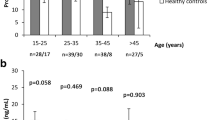Abstract
Sodium valproate, a GABAergic agent (800 mg), and placebo were administered orally, as a single dose, to nine chronic schizophrenics with tardive dyskinesia (TD), seven chronic schizophrenics without TD and ten healthy controls, according to a double blind design. Blood samples were collected before and after drug administration, to determine plasma prolactin concentrations. Sodium valproate decreased plasma prolactin levels in healthy subjects (P<0.001) and in schizophrenic patients with TD (P<0.001), but not in chronic schizophrenics without TD. Moreover, in dyskinetic subjects, the maximum per cent decrease of plasma prolactin from basal value was positively correlated to the score of the abnormal involuntary movement scale (r=0.724, P<0.02). Although the neural or biochemical substrate underlying the different responses of plasma prolactin to sodium valproate in schizophrenics with and without TD remains unclear, these results provide the first neuroendocrine evidence able to differentiate dyskinetic subjects from those without TD within a schizophrenic population.
Similar content being viewed by others
References
Andreasen NC (1981) Scale for the Assessment of Negative Symptoms (SANS). Iowa City, University of Iowa
Baldessarini RJ, Cole JO, Davis JM, Gardos G, Preskorn SH, Sympson GM, Tarsy D (1980) Tardive dyskinesia: report of the American Psychiatric Association Task Force on late neurological effects of antipsychotic drugs. American Psychiatric Association, Washington, DC
Clegorn JM, Brown PJ, Kaplan RD, Demer SW, MacCrimmon DJ, Mitton J (1983) Growth hormone response to apomorphine HCl in schizophrenic patients on drug holidays and at relapse. Br J Psychiatry 142:482–488
Coward DM (1982) Classical and non-classical neuroleptics induce supersensitivity of nigral GABAergic mechanisms in the rat. Psychopharmacology 78:180–184
Crow TJ, Cross AJ, Johnstone EC, Owen F, Owens DGC, Waddington JC (1982) Abnormal involuntary movements in schizophrenia: are they related to the disease process or its treatment? Are they associated with changes in dopamine receptors? J Clin Psychopharmacol 2:336–340
Fibiger HC, Lloyd KG (1984) Neurobiological substrates of tardive dyskinesia: the GABA hypothesis. TINS 12:462–464
Frey JM, Ticku MK, Huffman RD (1987) GABAergic supersensitivity within the pars reticulata of rat substantia nigra following chronic haloperidol administration. Brain Res 425:73–84
Gale K, Casu M (1981) Dynamic utilization of GABA in substantia nigra: regulation by dopamine and GABA in the striatum, and its clinical and behavioral implications. Mol Cell Biochem 39:369–405
Garbutt JC, van Kammen DP (1983) The interaction between GABA and dopamine: implications for schizophrenia. Schizophren Bull 9:336–353
Gunne LM, Häggström J-E, Sjöquist B (1984) Association with persistent neuroleptic-induced dyskinesia of regional changes in brain GABA syntesis. Nature 309:347–349
Klawans HL (1973) The pharmacology of tardive dyskinesia. Am J Psychiatry 130:82–86
Monteleone P, Iovino M, Barone P, Steardo L (1984) Plasma prolactin response to sodium valproate in epileptic patients. Neuroendocrinol Lett 6:157–162
Monteleone P, Zontini G, Steardo L (1985) Failure of the GABAergic drug, sodium valproate, to reduce basal plasma prolactin secretion in chronic schizophrenia. Psychoneuroendocrinology 10:475–480
Overall JE, Gorham DR (1962) The brief psychiatric rating scale. Psychol Rep 10:799–812
Racagni G, Apud JA, Cocchi D, Locatelli V, Müller EE (1982) GABAergic control of anterior pituitary hormone secretion. Life Sci 31:823–838
Scheel-Krüger J, Arnt J (1985) New aspects on the role of dopamine, acetylcholine, and GABA in the development of tardive dykinesia. In: Casey D, Chase T, Christensen AV, Gerlach J (eds) Dyskinesia — research and treatment. Springer, Berlin Heidelberg New York, pp 46–57
Spitzer RL, Endicott J, Robins E (1978) Research Diagnostic criteria: rationale and reliability. Arch Gen Psychiatry 35:773–782
Thaker GK, Tamminga CA, Alphs LD, Lafferman J, Ferraro TN, Hare TA (1987) Brain gamma-aminobutyric acid abnormality in tardive dyskinesia. Arch Gen Psychiatry 44:522–529
Author information
Authors and Affiliations
Rights and permissions
About this article
Cite this article
Monteleone, P., Maj, M., Ariano, M.G. et al. Prolactin response to sodium valproate in schizophrenics with and without tardive dyskinesia. Psychopharmacology 96, 223–226 (1988). https://doi.org/10.1007/BF00177564
Received:
Revised:
Issue Date:
DOI: https://doi.org/10.1007/BF00177564




